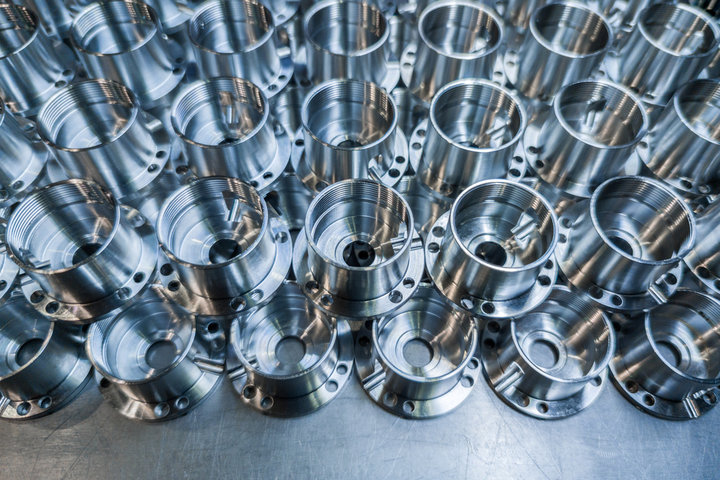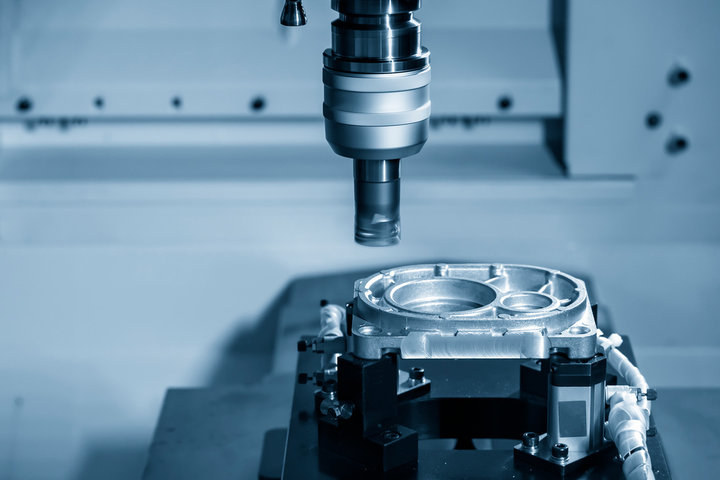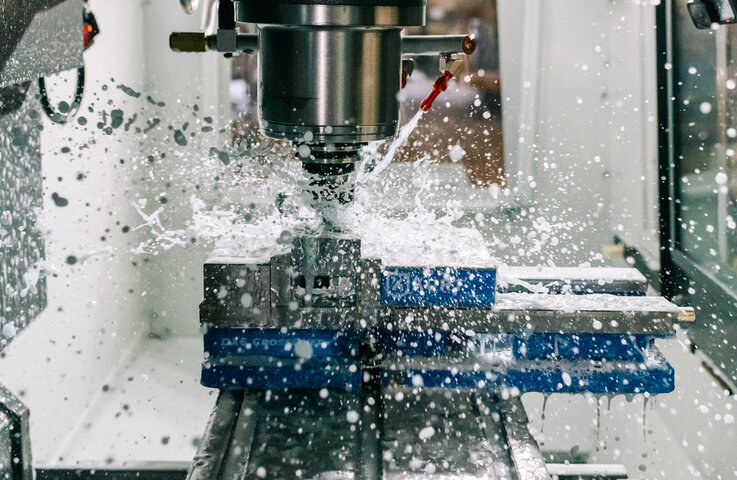CNC machined aluminum and cast aluminum are two popular metal fabrication techniques used in aluminum manufacturing projects. Choosing the right process between CNC machining and casting is a critical decision. When embarking on an aluminum manufacturing project, it's essential to understand the unique characteristics, benefits, and applications of each method to make an informed decision. In this blog, we'll explore the world of CNC machined aluminum and cast aluminum, comparing their properties, costs, and suitability for various metal fabrication projects. By understanding the differences between these two aluminum manufacturing processes, you can select the optimal technique that aligns with your project's specific requirements and goals, ensuring a successful outcome for your next aluminum fabrication endeavor.

What is CNC Machined Aluminum?
Understanding CNC Machining Process
CNC (Computer Numerical Control) machined aluminum refers to the process of shaping aluminum alloys using precision-controlled computer-controlled cutting tools. This advanced manufacturing method removes material from a solid block of aluminum to create the desired part geometry. The production process is renowned for its accuracy, repeatability, and ability to produce complex shapes with engineering-grade tolerances.
Popular Aluminum Alloys for CNC Machining
Common aluminum alloys used in industrial manufacturing include:
6061: Known for its superior material properties, including machinability, corrosion resistance, and good strength-to-weight ratio, making it a versatile manufacturing solution for various industries.
7075: Offers high-performance characteristics with exceptional strength and fatigue resistance, making it ideal for precision engineering applications in the aerospace and defense sectors.
2024: Provides optimized performance with balanced strength, fatigue resistance, and machinability, commonly used in advanced transportation and aerospace industries.
Key Industrial Applications
CNC machined aluminum finds applications across diverse industrial sectors, including:
Aerospace: Precision-crafted aircraft components, structural parts, and instruments
Automotive: Engine components, suspension systems, and lightweight engineered body parts
Medical: Quality-certified surgical instruments, implants, and diagnostic equipment
Electronics: Thermal-optimized heat sinks, enclosures, and connectors

What is Cast Aluminum?
Understanding Casting Process
Cast aluminum involves pouring molten aluminum alloy into a pre-shaped mold or die, allowing it to cool and solidify into the desired shape. This metal fabrication process is particularly suitable for producing large quantities of parts with consistent quality standards and complex geometries.
Types of Casting Methods
Various casting methods exist, each offering specific manufacturing advantages:
Die Casting: Molten aluminum is injected under high pressure into a steel die, enabling production-efficient manufacturing of high-volume, dimensionally accurate parts.
Sand Casting: Molten aluminum is poured into a sand mold, offering design flexibility and cost-effective solutions for low-to-medium volume production.
Permanent Mold Casting: Molten aluminum is poured into a reusable metal mold, providing precision results and quality surface finish for medium-to-high volume production.
Common Cast Aluminum Alloys
Typical aluminum alloys used in industrial casting include:
A380: Offers exceptional manufacturing properties including castability, pressure tightness, and good mechanical properties, widely used in the automotive and electronics industries.
A383: Provides reliable performance characteristics with good castability, corrosion resistance, and moderate strength, suitable for various engineering applications.
A360: Features advanced material properties including high strength, excellent corrosion resistance, and good machinability, often used in precision aerospace applications.
Industry Applications and Uses
Cast aluminum is used in diverse manufacturing applications, such as:
Automotive: Performance-engineered engine blocks, transmission cases, and wheel components
Aerospace: Precision-designed structural components, housings, and brackets
Consumer Goods: Quality-manufactured cookware, furniture, and decorative items
Industrial Equipment: Engineering-optimized pump housings, valve bodies, and machine tool components
How Do CNC Machined Aluminum and Cast Aluminum Differ?
When comparing CNC machined aluminum and cast aluminum, several key manufacturing process differences emerge:
Material Properties and Manufacturing Performance
CNC machining typically uses high-grade wrought aluminum alloys, which offer superior engineering properties including strength, ductility, and fatigue resistance compared to cast alloys. The precision manufacturing process also allows for greater control over the material's microstructure, resulting in more consistent quality standards throughout the part.
Cast aluminum alloys are specifically engineered for precision casting, offering excellent fluidity, production efficiency, and resistance to hot cracking. However, cast parts may have different material characteristics compared to machined parts due to the presence of porosity and inclusions.
Design Capabilities and Complexity
Advanced CNC machining offers unparalleled design optimization, enabling the creation of highly intricate geometries, thin walls, and precision-engineered tolerances. The manufacturing solution allows for the incorporation of complex features, such as undercuts, threads, and internal channels, without additional tooling.
Industrial casting also allows for the production of complex shapes, but the level of intricacy achievable depends on the specific metal processing method used. Die casting can produce precision components with thin walls and intricate details, while sand casting is more suitable for larger, less complex geometries.
Production Efficiency and Cost Optimization
The manufacturing cost-effectiveness of both processes largely depends on production volume and part complexity. CNC machining is ideal for sustainable manufacturing in low-to-medium volume production, offering quick turnaround times and minimal tooling costs. However, as part complexity increases, machining time and material usage also increase.
Advanced casting processes, particularly die casting, excel in high-volume manufacturing scenarios. While the initial tooling costs for casting can be substantial, the production efficiency increases significantly with volume. Casting also provides better material optimization compared to machining.
Surface Finish and Quality Control
CNC machining provides excellent quality assurance over the surface finish of aluminum parts. By selecting appropriate processing parameters, manufacturers can achieve various surface finishes, from matte to mirror-like. Additionally, machined parts can undergo secondary processing for enhanced aesthetic appeal and corrosion resistance.
Cast aluminum parts undergo specific quality control measures to manage surface characteristics, including parting lines, gate marks, and surface finish. However, various post-production treatments, such as shot blasting, sanding, and polishing, can significantly improve the final product quality.
Precision Engineering and Tolerance Capabilities
Advanced CNC technology is renowned for achieving extremely tight tolerances, often in the range of ±0.025 mm (±0.001 in) or better, depending on equipment capabilities and operator expertise. This level of precision control is essential for high-performance applications.
Modern casting technology, while capable of producing dimensionally accurate parts, typically has different tolerance specifications. Die casting can achieve industrial-grade precision of ±0.076 mm (±0.003 in) or better, while sand casting tolerances meet different manufacturing standards. Recent technological advancements have significantly improved casting precision.

What Are the Advantages of Using CNC Machined Aluminum?
CNC machined aluminum offers several distinct manufacturing advantages that make it an attractive choice for many industrial applications:
Suitability for low-volume, custom, or prototype production
Advanced CNC manufacturing provides quick setup times and minimal tooling requirements, making it ideal for producing small batches of precision-engineered parts. This production flexibility allows for rapid design optimization and short lead times, enabling faster time-to-market solutions for new products.
Ability to create complex geometries and tight tolerances
The precision engineering capabilities and versatility of modern CNC technology enable the creation of parts with intricate features, thin walls, and high-precision tolerances that would be challenging or impossible to achieve with casting. This technical advantage is particularly valuable for high-performance applications, such as aerospace components or automotive parts.
Excellent mechanical properties and durability
CNC machining typically uses high-grade wrought aluminum alloys, which offer enhanced mechanical characteristics including strength, ductility, and fatigue resistance compared to cast alloys. The quality-controlled process also allows for greater control over the material's microstructure, resulting in more consistent manufacturing standards throughout the part. These performance attributes make CNC machined aluminum parts well-suited for demanding industrial applications.
Flexibility in design changes and modifications
Advanced CNC processing allows for quick and efficient design iterations, as the part geometry is controlled by integrated CAD/CAM technology and CNC programming. This manufacturing flexibility enables producers to make rapid adjustments without significant production costs or delays associated with modifying casting tooling.
Wide range of surface treatments and finishes available
CNC machined aluminum components can undergo various quality enhancement processes to improve their surface finish, corrosion resistance, and aesthetic appeal. Common surface engineering treatments include anodizing, painting, plating, and polishing. These finishing solutions allow manufacturers to achieve specific performance requirements or customer specifications.
What Are the Benefits of Choosing Cast Aluminum?
Cast aluminum offers several compelling benefits that make it a popular choice for many manufacturing projects:
Cost-effectiveness for high-volume production
Casting, particularly die casting, is highly cost-effective for large-scale production runs. While the initial tooling costs for casting can be substantial, the cost per part decreases significantly as production volume increases. This economy of scale makes casting an attractive option for applications that require a large number of identical parts, such as automotive components or consumer goods.
Ability to create intricate shapes and thin-walled parts
Casting processes, especially die casting, can produce parts with complex geometries, intricate details, and thin walls that would be difficult or costly to achieve with machining. This capability enables designers to create more innovative and optimized part designs that can reduce weight, improve performance, and enhance overall product functionality.
Excellent surface quality with minimal porosity
Modern casting processes, coupled with advancements in mold design and process control, can produce parts with excellent surface quality and minimal porosity. Die casting, in particular, can achieve near-net-shape parts with smooth surfaces and tight dimensional tolerances, reducing the need for extensive post-casting machining or surface treatments.
Faster production times compared to CNC machining
Casting processes, especially high-pressure die casting, can produce parts at a much faster rate compared to CNC machining. Once the mold or die is created, multiple parts can be produced in rapid succession, with cycle times often measured in seconds or minutes. This high production rate makes casting an excellent choice for applications that require large quantities of parts in a short timeframe.
Possibility to integrate features like bosses and threads directly in the casting
Casting allows for the integration of functional features, such as bosses, ribs, and threads, directly into the part design. This capability eliminates the need for additional machining or assembly steps, streamlining the production process and reducing overall costs. By consolidating multiple components into a single casting, manufacturers can also improve part reliability and reduce potential points of failure.
How to Decide Between CNC Machined Aluminum and Cast Aluminum for Your Project?
Choosing between CNC machined aluminum and cast aluminum depends on several key factors specific to your project:
Consider production volume and scalability
If your project requires low-to-medium volume production or has the potential for design changes, CNC machining may be the more suitable option. However, if you need large quantities of identical parts and have a finalized design, casting can offer significant cost savings and faster production times.
Evaluate required precision and tolerance levels
If your application demands extremely tight tolerances and precise fit, CNC machining is likely the better choice. While casting processes have improved in terms of precision, they may still have limitations when it comes to achieving the same level of accuracy as machining.
Assess design complexity and customization needs
CNC machining offers greater design flexibility and the ability to create complex geometries and features. If your part design requires intricate details, thin walls, or custom features, machining may be the preferred option. However, if your part has a relatively simple geometry and can be produced using a standard mold or die, casting can be a cost-effective solution.
Compare project timelines and budget constraints
CNC machining typically offers faster turnaround times for small-to-medium production runs and has lower upfront tooling costs. If your project has a tight deadline or limited budget, machining may be the more suitable option. However, if you have a longer project timeline and can invest in the initial tooling costs, casting can provide long-term cost savings for high-volume production.
Consult with experienced manufacturing partners for guidance
Collaborating with knowledgeable professionals who have expertise in both CNC machining and casting can help you make an informed decision. These experts can provide valuable insights into the feasibility, cost-effectiveness, and lead times associated with each process, tailoring their recommendations to your specific project requirements.
Conclusion
Choosing between CNC machined aluminum and cast aluminum is a critical decision that can significantly impact the success of your manufacturing project. By understanding the key differences between these two processes, including their strengths, limitations, and applications, you can make an informed choice that aligns with your project's specific requirements and goals.
At Team Mfg, our team of skilled professionals has extensive experience in both CNC machining and aluminum casting. We understand the nuances of each process and can provide expert guidance to help you make the best decision for your project. Contact us today to discuss your requirements and learn how we can support you in bringing your aluminum components to life with precision, efficiency, and cost-effectiveness.
FAQs About CNC Machined Aluminum vs. Cast Aluminum
What tolerances can be achieved with CNC machined aluminum?
CNC machining can achieve extremely tight tolerances, often in the range of ±0.025 mm (±0.001 in) or better, depending on the machine's capabilities and the operator's skills. This precision is essential for applications requiring exact fit and function.
How does the strength of cast aluminum compare to CNC machined aluminum?
CNC machined aluminum parts typically have higher strength and better mechanical properties compared to cast aluminum parts. This is because wrought alloys used in CNC machining offer superior strength, ductility, and fatigue resistance.
What surface finishes are available for CNC machined aluminum parts?
CNC machined aluminum parts can achieve a wide range of surface finishes, from matte to mirror-like, depending on the cutting tools, speeds, and feed rates used. Secondary processes like anodizing, painting, or plating can further enhance the appearance and corrosion resistance.
Can complex geometries be created using die cast aluminum?
Yes, die casting can produce parts with complex geometries, thin walls, and intricate details that would be challenging or costly to achieve with CNC machining. This capability allows for more innovative and optimized part designs.
What is the maximum size of a part that can be CNC machined from aluminum?
The maximum size of a CNC machined aluminum part depends on the specific machine's working envelope. Large-scale CNC machines can accommodate parts measuring several meters in length, while smaller machines may be limited to parts up to a few hundred millimeters.


















